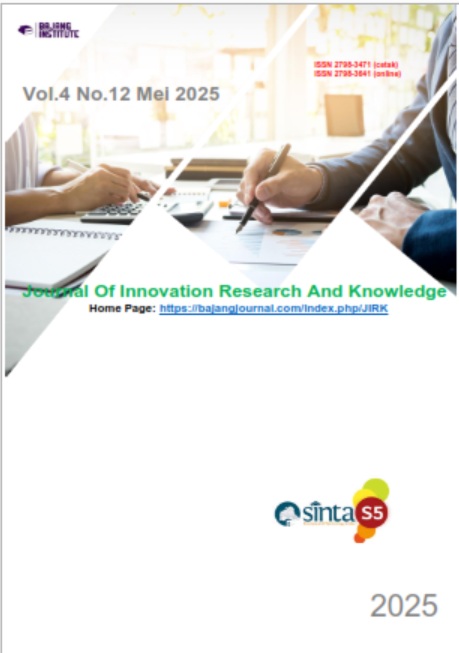INOVASI INTEGRASI ROBOTIC WELDING DAN POSITIONER SYSTEM UNTUK MENINGKATKAN EFISIENSI LEAN MANUFACTURING
Keywords:
Robotic Welding, Positioner System, Lean ManufacturingAbstract
Industri furnitur logam membutuhkan inovasi untuk meningkatkan efisiensi dan konsistensi kualitas. Penelitian ini merancang integrasi sistem robotic welding dengan positioner system dalam kerangka lean manufacturing untuk mengurangi pemborosan dan meningkatkan presisi produksi. Studi kasus dilakukan pada perusahaan furnitur logam, dengan analisis alur produksi menggunakan pendekatan Value Stream Mapping (VSM) untuk mengidentifikasi aktivitas yang tidak bernilai tambah. Hasil penelitian menghasilkan desain sistem otomatisasi yang mengintegrasikan robotic welding dan positioner system untuk mendukung efisiensi proses dan konsistensi hasil. Desain ini dirancang menggunakan perangkat lunak simulasi berbasis CAD (Computer Aided Design), dengan fokus pada penerapan prinsip lean manufacturing. Penelitian ini terbatas pada tahap desain tanpa uji implementasi lapangan. Studi lanjutan direkomendasikan untuk menguji performa desain dalam kondisi produksi nyata serta mengevaluasi dampaknya terhadap produktivitas dan efisiensi operasional.
References
Angin, N., and C. Tasdemir. “Identification of Internal Dynamics of Türkiye’s Furniture Industry in the Context of Lean Manufacturing Integration Maturity.” Business and Management Studies an International Journal 10, no. 2 (2022): 483–501. https://doi.org/10.15295/bmij.v10i2.2034.
Chen, S., and Z. Ye. “Intelligentized Technologies for Welding Manufacturing.” Materials Science Forum 773–774 (2013): 725–731. https://doi.org/10.4028/www.scientific.net/msf.773-774.725.
Choudhary, S., R. Nayak, M. Dora, N. Mishra, and A. Ghadge. “An Integrated Lean and Green Approach for Improving Sustainability Performance: A Case Study of a Packaging Manufacturing SME in the U.K.” Production Planning & Control 30, no. 5–6 (2019): 353–368. https://doi.org/10.1080/09537287.2018.1501811.
Farkas, A. “Impact of Industry 4.0 on Robotic Welding.” IOP Conference Series: Materials Science and Engineering 448 (2018): 012034. https://doi.org/10.1088/1757-899X/448/1/012034.
Fricke, C., and U. Buehlmann. “Lean and Virginia’s Wood Industry – Part I: Awareness and Implementation.” BioResources 7, no. 4 (2012): 5074–5093. https://doi.org/10.15376/biores.7.4.5074-5093.
Tejaswini, P., M. Achutha, and A. Doddagatte. “Development and Integration of Laser Sensor Tracking System in Robotic Arm for Path Correction during Welding Operation.” IAES International Journal of Robotics and Automation (IJRA) 11, no. 3 (2022): 196. https://doi.org/10.11591/ijra.v11i3.pp196-204.
Zeng, Q., X. Liu, Z. Liu, and A. Li. “Dynamic Characteristics Analysis of Two-Beam Laser Welding Robot for Fuselage Panels.” Research Square Preprint (2021). https://doi.org/10.21203/rs.3.rs-1086423/v1.
Zhang, Q., R. Xiao, Z. Liu, J. Duan, and J. Qin. “Process Simulation and Optimization of Arc Welding Robot Workstation Based on Digital Twin.” Machines 11, no. 1 (2023): 53. https://doi.org/10.3390/machines11010053.
Barros, L., L. Bassi, L. Caldas, A. Sarantópoulos, E. Zeferino, V. Minatogawa, et al. “Lean Healthcare Tools for Processes Evaluation: An Integrative Review.” International Journal of Environmental Research and Public Health 18, no. 14 (2021): 7389. https://doi.org/10.3390/ijerph18147389.
Chen, J., and R. Cox. “Value Stream Management for Lean Office—A Case Study.” American Journal of Industrial and Business Management 2, no. 2 (2012): 17–29. https://doi.org/10.4236/ajibm.2012.22004.
Effendi, R. “Efficiency Unleashed: Lean Manufacturing Strategies in Analyzing the Plastic Packaging Production Process.” Dinamis 11, no. 2 (2023): 51–63. https://doi.org/10.32734/dinamis.v11i2.13456.
Novirani, D. “Application of Lean Manufacturing to Minimize Waste in the Production Process of Tin Stabilizer.” E3S Web of Conferences 484 (2024): 01002. https://doi.org/10.1051/e3sconf/202448401002.
Vienažindienė, M., and R. Čiarnienė. “Lean Manufacturing Implementation and Progress Measurement.” Economics and Management 18, no. 2 (2013). https://doi.org/10.5755/j01.em.18.2.4732.
Bock, T., et al. “The Impact of Robotic Welding on Manufacturing Efficiency.” Journal of Manufacturing Processes 31 (2018): 123–134.
Groover, M. P. Automation, Production Systems, and Computer-Integrated Manufacturing. Pearson, 2016.
Gupta, B. K., and R. K. Gupta. “Robotic Welding: A Review.” International Journal of Advanced Manufacturing Technology 94, no. 1–4 (2018): 1–16.
Rother, M., and J. Shook. Learning to See: Value Stream Mapping to Add Value and Eliminate Muda. Lean Enterprise Institute, 2003.
Lin, C., Z. Wang, Y. Mo, and H. Pan. “The Path Planning of Synchronous Cooperative Motion Control between Robot and Positioner for Complex Space Curve Processing.” Electronics 9, no. 11 (2020): 1917. https://doi.org/10.3390/electronics9111917.
Ouyang, F. “Offline Motion Planning and Simulation of Two-Robot Welding Coordination.” Frontiers of Mechanical Engineering 7, no. 1 (2012): 81–92. https://doi.org/10.1007/s11465-012-0309-4.
My, C., D. Bien, B. Tung, L. Hieu, N. Công, and T. Hieu. “Inverse Kinematic Control Algorithm for a Welding Robot-Positioner System to Trace a 3D Complex Curve.” Proceedings of the 2019 11th International Conference on Advanced Technologies (ATC), 2019. https://doi.org/10.1109/atc.2019.8924540.
Gao, J., A. Pashkevich, and S. Caro. “Optimization of the Robot and Positioner Motion in a Redundant Fiber Placement Workcell.” Mechanism and Machine Theory 114 (2017): 170–189. https://doi.org/10.1016/j.mechmachtheory.2017.04.009.
Cegielski, P., D. Golański, P. Kołodziejczak, A. Kolasa, and T. Sarnowski. “The Analysis of Industrial Robot – External Axes System Movements with the Use of Virtual Off-Line Programming.” Welding Technology Review 90, no. 10 (2018). https://doi.org/10.26628/wtr.v90i10.962.
Chen, Y., and Q. Hu. “Dual-Robot Stud Welding System for Membrane Wall.” Industrial Robot: The International Journal of Robotics Research and Application 49, no. 1 (2021): 132–140. https://doi.org/10.1108/ir-03-2021-0049.















